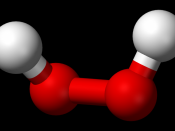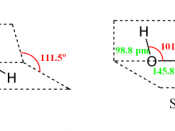Aim
I am going to investigate how the temperature affects the catalyse enzyme on hydrogen peroxide, using potato discs for the catalyse.
Hypothesis
Catalyse is a biological enzyme which works best between 30 and 40 degrees, like most enzymes. It also has an optimum pH.
Catalyse breaks down Hydrogen Peroxide into water and oxygen. Plant and animal cells contain catalyse.
`I predict that the catalyse enzyme found in the potato will break down the substrate (Hydrogen Peroxide) quickest at 37- 40 degrees Celsius because enzymes work best at certain temperatures, usually body temperature. If the temperature is above 40 degrees the enzyme will become denatured so molecules of Hydrogen Peroxide won't be able to fit into it and so they can't form an enzyme substrate complex and can't be broken down, so no oxygen or water is created. If it is below 37 degrees the amount of activity is reduced, as temperature is a limiting factor in this part of the experiment.
I predict that the graph for the total oxygen evolved will look like this:
I think this because between A and B the rate of reaction increases the molecules of Hydrogen Peroxide will have more kinetic energy and so there will be more collisions, as they move around the container and hit each other. More enzyme substrate complexes will be formed and so more oxygen and water is formed.
At point B the temperature is the optimum.
Between points B and C the temperature is too high for the enzyme to work and the shape of the active site is damaged. The reaction slows down, as the enzyme is eventually denatured.
Equipment
Stop clock
10ml measuring cylinder
Delivery tubes
Bung
Googles
Hydrogen peroxide (...ml each time)
Potato discs (40 1mm thick)
Controls
Amount of hydrogen peroxide...


